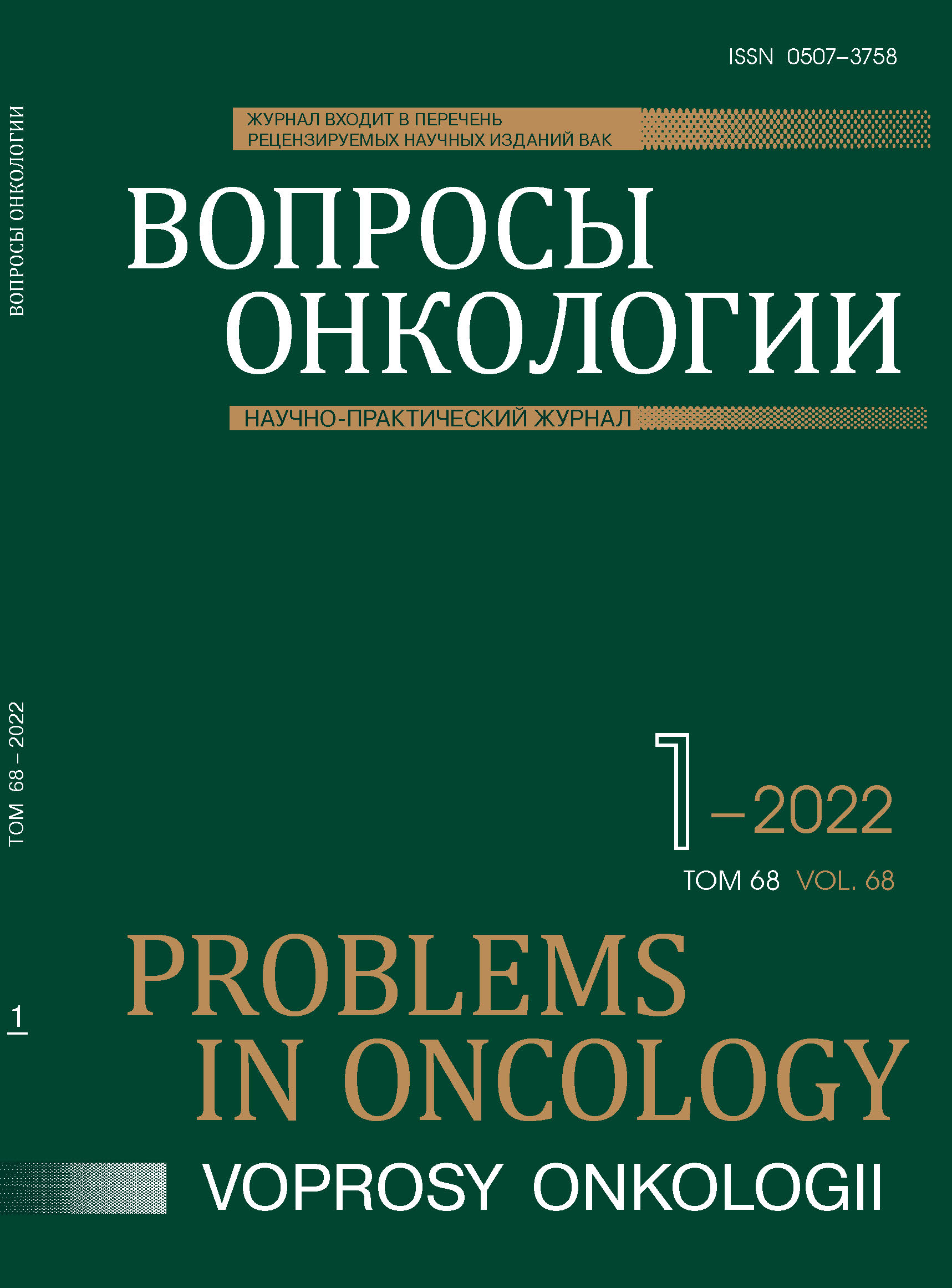Abstract
Materials and methods. The study included 18 patients with breast cancer (T1–4N0–2M0) before systemic treatment: 10 — with HER2/neu overexpression; 8 — HER2/neu negative. In all cases, morphological, immunohistochemical studies, as well as FISH analysis of the primary tumor were performed. All patients underwent radionuclide studies (planar scintigraphy and SPECT of the chest) at 2, 4, 6 and 24 hours after injection of the «99mTc-DARPinG3» in dosages of 1000 and 2000 μg.
Results. The half-life of the labeled protein from the blood was 3.5 hours for a dosage of 1000 μg; 3.8 h — for 2000 mcg. The organ with the highest absorption of «99mTc-DARPinG3» was the kidneys, regardless of the protein dose (0.10±0.02 and 0.10±0.03 mGy, respectively). The effective dose for 1000 μg was 0.011±0.001 mGy; for 2000 μg — 0.012±0.006. The liver absorption dose was significantly higher with 1000 μg of protein compared to 2000 μg (p<0.005, Mann–Whitney U test). The tumor/background ratio was significantly higher at 2 and 4 hours after administration of the «99mTc-DARPinG3» in patients with HER2-positive tumors in 1000 and 2000 μg doses of protein (p<0.005, Mann–Whitney U test).
Conclusion. Clinical studies of the «99mTc-DARPinG3» in dosages of 1000 and 2000 μg demonstrated rapid elimination from the bloodstream and effective doses comparable to those obtained in the study with others alternative scaffold proteins labeled with various isotopes. An essential point of this work is the positive correlation of the protein dose with the accumulation of the compound in the liver, which is important component in diagnostic and allows to detect tumor sites in liver.
References
Zavyalova M, Vtorushin SV, Telegina N et al. Clinicopathological features of nonspecific invasive breast cancer according to its molecular subtypes // Experimental Oncology. 2016;38(2):122–127.
Babyshkina N, Malinovskaya E, Cherdyntseva N et al. Neoadjuvant chemotherapy for different molecular breast cancer subtypes: a retrospective study in Russian population // Medical Oncology. 2014;9 (31):1–12.
Wolff AC, Hammond MEH, Hicks DG et al. Recommendations for human epidermal growth factor receptor 2 testing in breast cancer: American Society of Clinical Oncology/College of American Pathologists clinical practice guideline update // J Clin Oncol. 2013;31:3997 4013. doi:10.1200/JCO.2013.50.9984
Bartley AN, Washington MK, Ventura CB et al. HER2 testing and clinical decision making in gastroesophageal adenocarcinoma: guideline From the College of American Pathologists, American Society for Clinical Pathology, and the American Society of Clinical Oncology // J Clin Oncol 2017;35:446–464. doi:10.5858/arpa.2016-0331-CP
Furrer D, Sanschagrin F, Jabod S et al. Advantages and disadvantages of technologies for HER2 testing in breast cancer specimens // Am J Clin Pathol. 2015;144(5):686 703. doi:10.1309/AJCPT41TCBUEVDQC
Брагина О.Д., Чернов В.И., Зельчан Р.В. и др. Альтернативные каркасные белки в радионуклидной диагностике злокачественных образований // Бюллетень сибирской медицины. 2019;18(3):125–133. doi:10.20538/1682-0363-2019-3-125–133 [Bragina OD, Chernov VI, Zelchan RV et al. Alternative scaffolds in radionuclide diagnosis of malignancies // Byulleten' sibirskoi meditsiny. 2019;18(3):125–133 (In Russ.)]. doi.:10.20538/1682-0363-2019-3-125–133
Krasniqi A, D’Huyvetter M, Devoogdt N et al. Same-Day Imaging Using Small Proteins: Clinical Experience and Translational Prospects in Oncology // Journal of Nuclear Medicine. 2018;59:885–891. doi:10.2967/jnumed.117.199901
Shilova O.N, Deyev S.M. DARPins: Promising Scaffolds for Theranostics // Acta Nature. 2019;11. №1:42–53. doi:10.32607/20758251-2019-11-4-42-53.
Sandström M, Lindskog K, Velikyan I et al. Biodistribution and radiation dosimetry of the anti-HER2 Affibody molecule 68Ga-ABY-025 in breast cancer patients // J Nucl Med. 2016;57(6):867–871. doi:10.2967/jnumed.115.169342
Bragina O, Witting E, Garousi J et al. Phase I study of 99mTc-ADAPT6, a scaffold protein-based probe for visualization of HER2 expression in breast cancer // J Nucl Med. 2021;42(4):493–499. doi:10.2967/jnumed.120.248799
Chernov V, Sinilkin I, Choynzonov E et. al. Comparative evaluation on 99mTc-fitat nanocolloids for sentinel lymph nodes visualisation in patients with cancer of larynx and hypopharynx // European Journal of Nuclear Medicine and Molecular Imaging. 2015;42(S1):704.
Брагина О.Д., Ларькина М.С., Стасюк Е.С. и др. Разработка высокоспецифического радиохимического соединения на основе меченных 99mTc рекомбинантных адресных молекул для визуализации клеток с гиперэкспрессией Her2/neu // Бюллетень сибирской медицины. 2017;16(3):25–33. doi:10.20538/1682-0363-2017-3-25–33 [Bragina OD, Larkina MS, Stasyuk ES et al. Development of highly specific radiochemical compounds based on 99mTc-labeled recombinant molecules for targeted imaging of cells overexpressing Her-2/neu // Byulleten' sibirskoi meditsiny. 2017;16(3):25–33 (In Russ.)]. doi:10.20538/1682-0363-2017-3-25–33
Bragina O, Chernov V, Schulga A et.al. Phase I trial of 99mTc-(HE)3-G3, a DARPin-based probe for imaging of HER2 expression in breast cancer // Journal of Nuclear Medicine. 2021, jnumed.121.262542. doi:10.2967/jnumed.121.262542
Брагина О.Д., Чернов В.И., Гарбуков Е.Ю. и др. Возможности радионуклидной диагностики Her2-позитивного рака молочной железы с использованием меченных технецием-99m таргетных молекул: первый опыт клинического применения // Бюллетень сибирской медицины. 2021;20(1):23–30. https://doi.org/10.20538/1682-0363-2021-1-23-30 [Bragina OD, Chernov VI, Garbukhov EYu et al. Possibilities of radionuclide diagnostics of Her2-positive breast cancer using technetium-99m-labeled target molecules: the first experience of clinical use // Bulletin of Siberian Medicine. 2021;20(1):23–30 (In Russ.)]. doi:10.20538/1682-0363-2021-1-23-30
Брагина О.Д., Чернов В.И., Таширева Л.А. и др. Определение наиболее информативных прогностических параметров для оценки статуса рецептора эпидермального фактора роста HER2/neu у больных раком молочной железы при использовании таргетного радионуклидного препарата «99mTс-ADAPT6» // Вопросы онкологии. 2021;67(3):368–373. doi:10.37469/0507-3758-2021-67-3-368-373 [Bragina O.D., Chernov V.I., Tashireva L.A. et al. Determination of the most informative prognostic parameters for assessing the status of the epidermal growth factor receptor Her2/neu in the primary tumor in breast cancer patients using the targeted radiopharmaceutical «99mTс-ADAPT6» // Voprosy onkologii. 2021;67(3):368–373 (In Russ.)]. doi:10.37469/0507-3758-2021-67-3-368-373

This work is licensed under a Creative Commons Attribution-NonCommercial-NoDerivatives 4.0 International License.
© АННМО «Вопросы онкологии», Copyright (c) 2021
